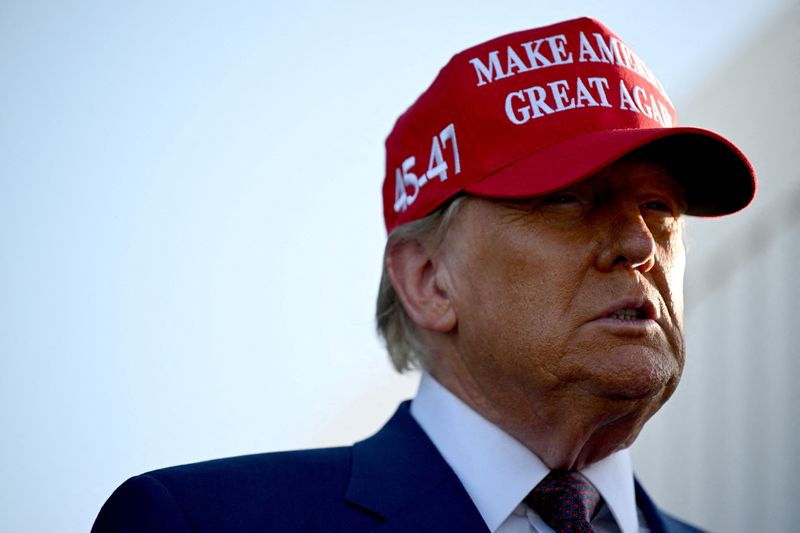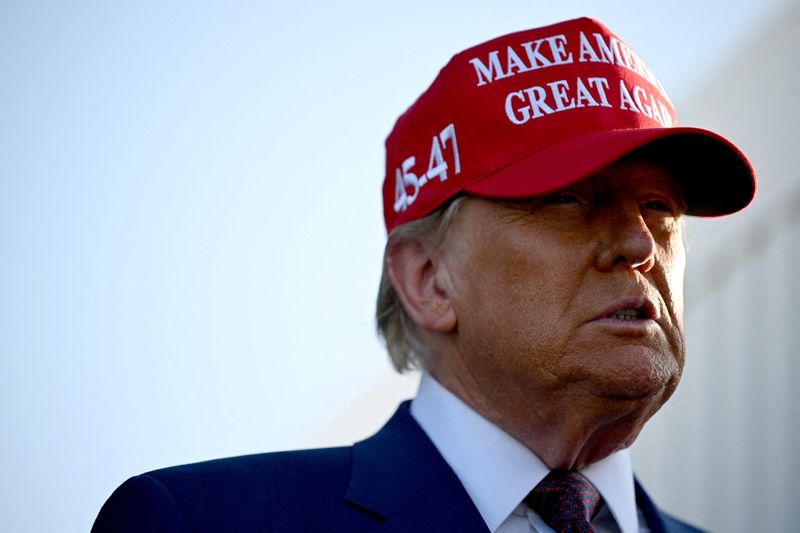
By Alden Bentley, Harry Robertson and Ankur Banerjee
NEW YORK/LONDON/SINGAPORE (Reuters) -A pledge by President-elect Donald Trump to impose tariffs on products from Canada, Mexico and China sent their currencies lower against the dollar on Tuesday, renewing the specter of trade wars and fanning uncertainty in other currency pairs.
Trump said that on his first day in office, he would impose a 25% tariff on all products from Mexico and Canada. On China, he said Beijing was not taking strong enough action to curb the export of ingredients used in illicit drugs, floating “an additional 10% tariff, above any additional tariffs, on all of their many products coming into the United States of America”.
Trading was thin ahead of Thursday’s U.S. Thanksgiving holiday, which spills into Friday, when many traders also take off.
The dollar initially jumped more than 2% against the peso and was last up 1.57% at 20.5992 pesos.
“Because we are in the week that we’re in, the statements have not, I don’t think, caused all of the damage that we are yet to see. But of course, the peso is vulnerable to falling into those multi year lows against the US dollar,” said Juan Perez, director of trading at Monex USA, in Washington, DC.
The dollar hit a 4-1/2-year high against its Canadian counterpart, rising more than 1.5%, and was last up 0.69% at C$1.4082. The U.S. currency also rose to its highest since July 30 against China’s yuan and was trading at 7.26 yuan.
“I think we had a perfect example last night of why volatility is more likely under Trump,” said Jane Foley, head of FX strategy at Rabobank.
“He can just put out a comment like that outside of usual U.S. market hours that takes people by surprise. It leaves investors, everybody scrambling to work out what this really means.”
Otherwise, the dollar was a bit on defence after Trump’s announcement Friday that of hedge fund manager Scott Bessent would become U.S. Treasury Secretary, which buoyed government bonds and sent yields lower.
It was last down 0.38% at 153.63 yen while the euro was up 0.05% at $1.0499.
The dollar index was at 106.89, versus 106.86 late Monday.
Perez said the tariff news helps the yen as a safe haven. “Any type of turbulence and turmoil that may be thrown in the way of China, it’s not necessarily always going to be a benefit for Japan, but it opens room for Japan to negotiate more of a place of leadership once again in Asia.”
Scheduled news is on the light side this week, with the main events being the minutes from the Federal Open Market Committee’s November meeting due at 2 p.m. EST/1900 GMT and on Wednesday the October Personal Consumption Expenditures price index.
Erik Nelson, macro strategist at Wells Fargo (NYSE:WFC), said some investors may have been buying the euro to close their previous bets against the euro-Canadian dollar currency pair, which some had seen as a “Trump trade” in the belief Europe would be hit harder by tariffs than Canada.
The Australian dollar sank to a more than three-month low of $0.6434 in early Asian trading and was last down just 0.57% at $0.6465. The Aussie is often sold as a liquid proxy for the yuan given China is Australia’s biggest trading partner. [AUD/]

In cryptocurrencies, bitcoin was trading at $93,334, well below the record high of $99,830 it touched last week.
Bitcoin met profit-taking ahead of the symbolic $100,000 barrier, having climbed more than 40% since the U.S. election on expectations Trump will loosen the regulatory environment for cryptocurrencies.
This post is originally published on INVESTING.



